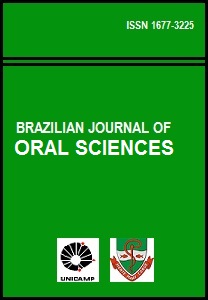Abstract
The study focused on verifying the prevalence of Temporomandibular Dysfunction in children, correlating it to their parafunctional habits. A questionnaire was utilized, which was answered by the mothers of 90 children aging three to seven years old (49 girls and 41 boys). The questionnaire inquired whether the child presented pain in the TMJ, head, ears, or in the neck region; tiredness or difficulty when chewing; if he/she used pacifier; habits like biting pens, chewing gum, teeth grinding or clenching, and biting the nails. Among the interviewed girls, 53% showed some sign or symptom of TMD, while among the boys, this prevalence was 39%. The most common complaint was headache. When considering the habits, they were more frequent among the children who presented pain or discomfort. So, parafunctions can be an important factor contributing to the etiology of the dysfunctions.References
Teixeira ACB, Marcucci G, Luz JGC. Prevalência das maloclusões e dos índices anamnésicos e clínicos em pacientes com disfunção da articulação temporomandibular. Rev Odontol Univ S Paulo 1999; 13: 251-6.
Correia FAS. Prevalência da sintomatologia nas disfunções da articulação temporomandibular e suas relações com idade, sexo e perdas dentais [dissertation]. São Paulo: USP/FO; 1983. p.84-5.
Ramos HAD. Sinais e síntomas das disfunções dolorosas da articulação temporomandibular. Odonto Cad Doc 1992; 34: 252-5.
Souza JAS. Síndrome da articulação temporomandibular. RGO 1980; 38: 295-8.
Santos AS, Nunes R, Martins EA. Síndrome de dor e disfunção do sistema estomatognático – análise anamnésica de 110 casos. RGO 1986; 34: 452-4.
Magnusson T, Carlsson GE, Egermark I. Changes in clinical signs of craniomandibular disorders from the age of 15 to 25 years. J Orofac Pain 1994; 8: 207-13.
Cirano GR, Rodríguez CRMD, Oliveira MDM, Lopes LFD. Disfunção de ATM em crianças de 4 a 7 anos: prevalência de sintomas e correlação destes com fatores predisponentes. RPG: Rev Pos-Grad 2000; 7: 14-21.
Hara EB, Camargo FG, Attizzani A. Sinais e sintomas de disfunção temporomandibular em crianças. Rev Odontol Univ S Paulo 1998; 16: 91-102.
Shinkai RSA, Santos LM, Nobre dos Santos M. Contribuição ao estudo da prevalência de bruxismo excêntrico noturno em crianças de 2 a 11 anos de idade. Rev Odontol Univ S Paulo 1998; 12: 29-37.
Jersil AJ. Psicologia da criança. 2.ed. Minas Gerais: Itatiaia; 1973.
Mc Donald HE, Avrry DH. Odontopediatria. 4.ed. Rio de Janeiro: Guanabara Koogan; 1986.
Almeida JCS, Silva RHH, Cardoso AC. Disfunção do sistema estomatognático em crianças: estudo da prevalência de alguns sinais e sintomas da síndrome, dor e disfunção mio-funcional em escolares na faixa etária de 7 a 12 anos. RGO 1989; 37: 251-4.
Ahmad R. Bruxism in children. J Pedod 1986; 10: 105-5.
Maciel RN. Oclusão e ATM : procedimentos clínicos. São Paulo: Santos; 1996.
Widmalm SE, Christiansen RL, Gunn SM, Hawley LM. Prevalence of signs and symptoms on craniomandibular disorders and orofacial parafunction in 4-6 years old AfricanAmerican and Caucasian children. J Oral Rehabil 1995; 22: 87-93.
Gussom DGD. Bruxismo em crianças. J Bras Odontopediat 1998; 1: 75-97.
The Brazilian Journal of Oral Sciences uses the Creative Commons license (CC), thus preserving the integrity of the articles in an open access environment.

